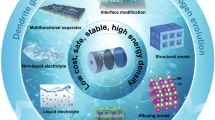Abstract
This study investigated the effect of plastic deformation on anodic dissolution in electrochemical migration (ECM) through the growth of deposits. The morphology of deposits synthesized by ECM was analyzed using scanning electron microscopy, where sponge-shaped deposits were observed on the cathode electrode. The mechanism of anodic dissolution was examined by experimentally measuring the variation in the mass of electrodes. The increase and saturation of anodic dissolution in ECM with plastic deformation were observed and were empirically formulated in terms of the change in activation energy. Thus, plastic deformation is proposed as a promising parameter that contributes to controlling ECM.



Similar content being viewed by others
References
T. Djenizian, I. Hanzu, M. Eyraud, and L. Santinacci: Electrochemical fabrication of tin nanowires: a short review. Comptes Rendus Chim. 11, 995 (2008).
M. Motoyama and F.B. Prinz: Electrodeposition and behavior of single metal nanowire probes. ACS Nano 8, 3556 (2014).
X. Zhang, D. Li, L. Bourgeois, H. Wang, and P.A. Webley: Direct electro-deposition of porous gold nanowire arrays for biosensing applications. ChemPhysChem 10, 436 (2009).
M.Z. Atashbar and S. Singamaneni: Room temperature gas sensor based on metallic nanowires. Sensors Actuators, B Chem. 111–112, 13 (2005).
T. Takemoto, R.M. Latanision, T.W. Eagar, and A. Matsunawa: Electrochemical migration tests of solder alloys in pure water. Corros. Sci. 39, 1415 (1997).
R. Abbel, L. van de Peppel, G. Kirchner, J.J. Michels, and P. Groen: Lifetime limitations in organic electronic devices due to metal electrochemical migration. MRS Commun. 7, 664 (2017).
T. Aoki, Y. Li, and M. Saka: A proposal of fabrication method for Cu oxide micro-structure using ion migration. In Proceedings of the 2016 Annual Meeting of JSME Tohoku Regional Student Division, 22, 2016, in Japanese.
S. Fukaya, T. Aoki, Y. Kimura, and M. Saka: Enhanced fabrication of hybrid Cu-Cu2O nanostructures on electrodes using electrochemical migration. Mech. Eng. Lett. 4, 17–00604 (2018).
T. Aoki, Y. Li, and M. Saka: Morphology control of hybrid Cu–Cu2O nano-structures fabricated by electrochemical migration. Mater. Lett. 236, 420 (2019).
T. Nakajima, Y. Li, and M. Saka: Study on utilization of ionic migration for fabrication of Ag nanodendrites. In Proceedings of the 2015 Materials and Mechanics Conference of JSME, GS0707, 2015, in Japanese.
T. Nakakura and M. Saka: Fabrication of large-scale Ag micro/nanostruc-tures using electrochemical migration. Micro Nano Lett. 13, 923 (2018).
A.R. Despic, R.G. Raicheff, and J. O’M. Bockris: Mechanism of the acceleration of the electrodic dissolution of metals during yielding under stress. J. Chem. Phys. 49, 926 (1968).
J.O’M. Bockris and P.K. Subramanyan: Contributions to the electrochemical basis of the stability of metals. Corros. Sci. 10, 435 (1970).
R.E. Fryxell and N.H. Nachtrieb: Effect of stress on metal electrode potentials. J. Electrochem. Soc. 99, 495 (1952).
L. Yang, G.T. Horne, and G.M. Pound: Physical Metallurgy of Stress Corrosion Fracture (Interscience Publishers, New York, 1, 1959).
N. Ohtani: Strain electrode. Bull. Jpn. Inst. Met. 46, 233 (1973) in Japanese.
T.P. Hoar and J.C. Scully: Mechanochemical anodic dissolution of austen-itic stainless steel in hot chloride solution at controlled electrode potential. J. Electrochem. Soc. 111, 348 (1964).
R.G. Raicheff, A. Damjanovic, and J. O’M. Bockris: Dependence of the velocity of the anodic dissolution of iron on its yield rate under tension. J. Chem. Phys. 47, 2198 (1967).
E.M. Gutman, G. Solovioff, and D. Eliezer: The mechanochemical behavior of type 316L stainless steel. Corros. Sci. 38, 1141 (1996).
A. Nazarov, V. Vivier, D. Thierry, F. Vucko, and B. Tribollet: Effect of mechanical stress on the properties of steel surfaces: scanning Kelvin probe and local electrochemical impedance study. J. Electrochem. Soc. 164, C66 (2017).
Y. Kimura and M. Saka: On growth of a micro/nano-material under migration. In Proceedings of the 2017 Autumn Meeting of JSME Tohoku Regional Division, 105, 2017, in Japane
T. Murata: Theory of strain electrode and the application to corrosion study (2). Dynamic straining of non-filmed electrode at constant strain rate. Corros. Eng. 22, 133 (1973) in Japanese.
T. Murata: Practical application of strain electrode methods. Tetsu-to-Hagané 60, 580 (1974) in Japanese.
N. Ohtani and Y. Hayashi: Analysis of crack propagation rate in stress corrosion cracking by a mechanochemical model. J. Jpn. Inst. Met. Mater. 38, 1103 (1974) in Japanese.
F. Appel: Thermally activated dislocation processes in NaCl single crystals (I). Phys. Status Solidi A 25, 607 (1974).
Acknowledgment
This study was supported by a Grant-in-Aid for JSPS KAKENHI Grant-in-Aid for Scientific Research (B) No. 17H03139. This study was performed at the Micro/ Nano-Machining Research and Education Center of Tohoku University.
Author information
Authors and Affiliations
Corresponding author
Rights and permissions
About this article
Cite this article
Kimura, Y., Wakayama, S. & Saka, M. Plastic deformation affecting anodic dissolution in electrochemical migration. MRS Communications 9, 773–777 (2019). https://doi.org/10.1557/mrc.2019.68
Received:
Accepted:
Published:
Issue Date:
DOI: https://doi.org/10.1557/mrc.2019.68




